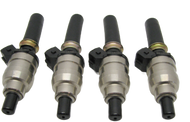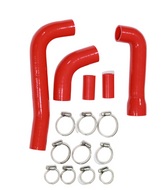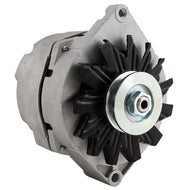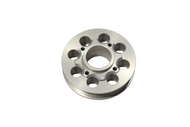Forced induction myths. This will upset some people.
I am writing this section to counter some of the misinformation in various internet forums and a few automotive magazines. It's semi advanced and if you don't know the difference between a Centrifugal and a Roots supercharger please read my descriptions on Supercharging HERE. Each of these systems have advantages and disadvantages and all can give outstanding results.
Some of the most knowledgeable people on the planet post information on the net. However, far more uniformed people post information. It's tough to sort out the good information from the bad. Sadly there is about twice as much misinformation as there is good information. Magazines are a little better. At least the writers of those articles have some basic qualifications. One problem with them is that magazines are beholden to their advertisers. Most can't stay afloat from subscription revenue alone. This tends to create articles which are written from a certain point of view and not likely to be overly critical of any product. Books are a great source of information. In some cases authors make errors but it's usually a case of an honest mistake. I own nearly every supercharging book in publication and all but one are very good.
The best, most accurate and unbiased information we can get on forced induction is from our own government. Prior to the Jet age, the government agency N.A.C.A., or the National Advisory Council on Aeronautics, did an incredible amount of research on piston engines and a large amount of it was devoted to forced induction. During World War II they had all the best piston engine experts in the country working for them with a nearly unlimited war time budget. They could build whatever test equipment they needed and test anything to destruction. Some might claim that since the reports they generated are old they are no longer valid. Nothing could be further from the truth. Engine basics have not changed, what worked then works now. The equipment they were testing was built with a wartime budget and while it might not be as good as modern military-spec hardware, it was at least as good as the stuff we now have in the automotive aftermarket. For example, in 1938 military aircraft engines had superchargers with an adiabatic efficiencies of 75%. They were up over 80% in laboratory testing just a few years later during the war. Those numbers are about the same as the very best automotive units today. The only real drawback is that the reports are written with a lot of aviation and not automotive terms. For example they never talk about supercharger or turbocharger boost, they talk about critical altitude. Now as an active pilot and flight engineer I can convert all of this information into automotive data. A critical altitude of 20,000 feet requires about 8 pounds of boost. Nearly everything I write on forced induction is backed up by data in the N.A.C.A. reports.
So without further delays lets blow holes in some of the B.S. out there.
Myth 1: The energy it takes to spin a turbocharger is free
I love turbochargers as much as anybody. In fact my daily driver is a turbo car, but if I had a nickel for every person that incorrectly claims the energy to drive a turbocharger is "free" I would be a rich man. The turbocharger's drive system is more mechanically efficient than the belt on a supercharger, but it's not free. The most basic laws of physics say that nothing is free. Some people have changed the terminology to say that the turbo is driven by "wasted energy". That's more nonsense. The energy needed to expel the exhaust from the combustion chamber is not wasted, in fact it's rather essential. Many makers of Turbo kits phrase it another clever way. They say that the energy needed to drive the turbo is "not taken directly from the crankshaft like it is with a belt driven supercharger". Ok, well at least that's basically true although somewhat misleading. It may not be taken "directly from the crankshaft" but it is taken from the engine. So how is the energy taken, and how much is used?
Here are the facts as reported in many N.A.C.A. reports. Exhaust drives the turbocharger and that causes exhaust backpressure robbing power as surely as if the compressor section was connected to a belt. It may not rob as much (it's possible under some conditions it will rob more) but it does rob power. Here is a quote from N.A.C.A. " When an exhaust turbosupercharger is used, the net engine power is the total engine power supercharged less the reduction in power due to increased exhaust back pressure." So there you have it, turbos cause exhaust back pressure taking power away from the engine. The report goes on to say just how much the loss from exhaust back pressure is going to cost and I assure you it's not free. If it was, then all the efforts made in the performance industry to reduce backpressure via special mufflers, headers etc. would be wasted. So just how much power will the turbo consume? They compiled a ton of data on that. It will vary somewhat from engine to engine, even between two theoretically identical engines. The number they came up with is 6.2% of total engine horsepower when using 10 pounds of boost. That's assuming exhaust pressure in the manifold between the combustion chamber and the turbine is equal to intake manifold pressure. It's important to understand, that's a best case scenario. A turbo car will need very good nonrestrictive equal length exhaust manifolds and a perfectly sized turbocharger to achieve this. I suspect the best manifolds made for race cars by masters like Jim Steck or the mad South Africans are good enough to get these results. In practice when limited by engine compartment space, strength requirements, and other factors, it's not likely you will find a manifold this good on a street Alfa. Many turbo cars have double the intake pressure in the exhaust manifold prior to the turbine. At 10 pounds of boost that would cost about 15.3% of the engine's horsepower using N.A.C.A.'s formula.
Time to plug in some real world numbers. A MP62 supercharger providing 10 pounds of boost on an Alfa 2.5 will use about 27 horsepower. It could potentially use less with optimal piping, but on my car it uses 27 horsepower so that's real world data. My car has about 250 flywheel horsepower, so using N.A.C.A.'s formula a very efficient turbo set up would need 15.5 horsepower to drive the turbo. While there is no doubt that 15.5 is less than 27, it's a factor that's small enough to be offset in other areas. Now using the same formula a turbo with a restrictive type of exhaust manifold will use 38.25 horsepower.
My point here is not to say that belt driven superchargers are better or worse. The point is that according to the best engineers in the U.S. at the time working with a nearly unlimited wartime budget determined that the energy to spin a turbocharger is not free. I am sure the brainwashed free energy crowd will state that these reports are old and turbos have come a long way. Of course if free energy was used to spin a turbo then it wouldn't matter how much they improved in this regard. An improvement of any percentage times zero is still zero. In other words: if they are free now because they are twice as efficient as the older units the math says the older units must have been free too.
Myth 2. Battle of the Boost
One major automotive magazine published an article titled "Battle of the Boost" a few years ago. It probably should have been called "battle to keep subscribers and advertisers happy." This article is constantly quoted in internet forums. It's usually quoted by people who just flipped to the results page of the article without reading the whole thing. The article was intended to be a comparison of a turbocharger, a centrifugal supercharger and a Roots supercharger on a small block Chevrolet V8. All 3 were non intercooled and set up for 9.5 pounds of boost.
The results showed that the Roots won out at low speed, the turbo in mid range and the centrifugal at very high RPM. The centrifugal passed the Roots in power at about 4000 rpm on the way to the engine's 6000 rpm redline. In summary all three types looked pretty good and a solid argument could be made for any of them. This keeps the advertisers and the loyalist of each type of device happy. However the conditions of the test were strongly adjusted against the Roots blower.
Here is what they did. The Roots blower they used was a model currently in production, however it's an ancient design. The Roots blower they used had two STRAIGHT lobes per rotor. This design literally dates back to the Civil War. Modern Roots blowers like the Eaton have three lobes per rotor and they have a 60 degree helix built into them. The older design takes far more power to drive and heats the air up an incredible amount compared to the newer type. The reasons are somewhat complex but the short version is this: Twin lobe straight rotors discharge the air in an on-and-off pulsing action. This heats up the air because it's constantly moving back and fourth. Triple helical lobe set ups discharge air constantly greatly minimizing these pulses.
The next factor working against the Roots was fairly obvious: it was not able to put out 9.5 psi due to pulley limitations. Now I don't know why that is. Did they just not have the right pulley? Did the proper pulley not fit the snout? Was the carburetor too restrictive? I don't know. What I do know is that an ancient design Roots at 8 psi is not going to compete favorably with the most modern centrifugal made running at 9.5 psi. It's just not a valid comparison. Had they used a Magnuson MP112 at 9.5 psi it would have been another story.
Myth 3: Replacing the Eaton M112 with a Lysholm design supercharger on a 2003 or 2004 Mustang Cobra will gain over 100 rear wheel horsepower at 13 pounds of boost
This particular issue is the most disturbing to me. Most of these myths are the result of concepts that are difficult to understand. This myth appears to have been intentionally created. I feel that the manufacturer involved here intentionally designed a misleading test which resulted in this myth. The editor of a major performance magazine stood by the test either because he didn't understand the test conditions or he just wanted to appease his advertiser. The sad thing here is that the manufacturer involved makes a GREAT supercharger. If you want to run 20 psi on your 2003 Cobra a screw supercharger is the way to go. That's way outside the operational range of the car's original Eaton because it's simply not big enough for that job.
One manufacturer of a screw supercharger kit has a report out there that was done under conditions that were heavily biased towards the screw supercharger. The results of this test are constantly thrown around by people who didn't read or understand the whole test. I can understand a manufacturer biasing the test in their favor. They didn't cheat, they just came up with an ideal scenario for their product.
Here is the deal. Some guy on the net posted results of his modified Eaton car vs a similar car with an aftermarket screw type. The screw supercharger put out more peak power but the car with the Eaton appeared to have a little better overall power curve. Now it's certainly possible the screw supercharged car did not have optimal tuning but it was still an interesting comparison as it showed that under certain conditions both types could be in the same ballpark.
The maker of the screw supercharger kit fired back saying that the car in the test must have had a bad tune and then posted their own test with both cars putting out 13+ pounds of boost at a mid range RPM level showing a screw supercharged car putting out over 100 more horsepower at the wheels. I consider this test to be highly misleading. When I first heard about it from some self proclaimed experts the version I heard was that the screw put out over 100 more horsepower at the wheels at the same level of boost. I knew right away this was nonsense as even if the screw supercharger used zero power to drive and didn't heat up the air at all it wouldn't have that much more power over the Roots at 13+ psi.
A thorough review of the test revealed the following facts. The increase of over 100 horsepower was not at the same boost level. The screw was over 16 psi and the Roots at 9.5. That's a huge difference. The trick here is that they used a screw supercharger sized in such a way that boost increased a lot with RPM so while both were at about the same boost level at mid range RPM the screw had much higher boost at redline. This is pretty easy to do. You take a supercharger that's oversized for its application and it will turn slowly and operate in a range where it has a steep volumetric efficiency curve. This results in boost increasing greatly with RPM. Had the Roots been set up to provide 16 psi at redline it would have had far more boost in mid range and would have outpowered the screw at lower and mid range RPM due to the flatter boost curve of a fast spinning Eaton.
The chart below shows why a larger supercharger's boost tends to increase with RPM.

As you can see in the chart, if a typical positive displacement supercharger is sized so that it operated in the lower RPM range on a given application, boost will increase greatly as the engine speeds up. Of course that defeats the whole idea of using a positive displacement blower in the first place. If you want boost to increase with RPM use a centrifugal supercharger. On the same engine, a properly sized positive displacement blower will operate in the higher range where the boost will stay relatively constant throughout the RPM range.
Like they say on T.V. "but wait there's more". Why did the Eaton have only 9.5 pounds of boost at redline when it had 13.5 at mid range rpm? They don't explain that in the report. I can say with certainty that boost does not fall off with an Eaton unless something is wrong. Keep in mind my Alfa with a MP62 has almost the exact same supercharger size to engine size ratio as the Eaton car in this test. In most cases boost falling off with the Eaton means the belt is slipping. As I wasn't there and I don't work on the same engines I can only speculate why the belt might have been slipping. The Eaton did use a much smaller pulley as it's a smaller supercharger. This decrease in pulley area may have combined with travel limitations of the belt tensioner to allow the belt to slip. The screw supercharger has a bigger pulley so the belt has more to bite and the supercharger kit certainly takes belt tension into account.
To top all this off both superchargers were run with the same tuning specs. I have no doubt that the tuning specs used were the specs designed for the screw supercharger, not the Eaton.
So we have an increase of well over 100 horsepower with the screw supercharger. However it's based on a 69% increase in boost. That's about as far from an apples to apples comparison as you can get.
Now for my non B.S. version of this test. Yes, screw superchargers are more efficient from a pure power standpoint. This is especially true during dyno testing or at the race track because the Roots cooler off boost temps don't have a chance to let the intercooler chill.
In this test the Screw supercharger put out slightly more power at the same level of boost which occurred at about 3500 rpm. At this point with equal boost the Roots put out about 325 at the wheels vs about 335 for the screw. That's hardly a massive increase. Especially when you consider the source of the test and the amount of money involved in this upgrade. At max power RPM the Screw supercharged car put out 25% more horsepower but it took 69% more boost to do it. When you factor in the Roots advantages in an apples to apples comparisons it becomes clear why it's the device of choice among Aston Martin, Lotus, G.M. Ford, etc. Those big manufacturers didn't go with an Eaton supercharger because I told them to. They didn't even ask me. They went with the Eaton because they did their own testing and research and determined it's the best unit for the job.
It's possible to take ANY supercharger and design a comparison test where it will come out looking better than ANY other supercharger. It's really not hard to do. Be very wary of supercharger comparison tests, especially done by organizations with a financial stake in the results like manufacturers and magazines with advertising. Your best defense is to learn and understand how these things work. Then read the tests carefully. They very rarely lie in these test, they just design the test to favor a certain product.
Myth 4: Overlap is bad!
Ok, the myth here is that on a supercharged engine any cam with any amount of overlap is bad. The theory being that boost will escape out the exhaust along with all the fuel while both intake and exhaust valves are open. Now valve overlap can be bad. If an engine has exhaust pressure higher than intake pressure like most turbocharged engines then it's possible for exhaust to dilute the intake charge during an overlap period. It's also possible to use so much overlap that a belt driven supercharger won't be able to provide much boost because it can escape out the exhaust valve. This is especially bad with an internal compression type supercharger (i.e. a Lysholm screw type, or a centrifugal) as the engine will have to use power to generate boost it won't use. However the right amount of overlap will help a supercharged engine. Here is a quote from General Electric. "Maintaining a high manifold pressure ahead of the intake valves allows the use of "valve overlap" in the engine, so that the intake valve opens just before the exhaust valve closes at the end of the exhaust stroke. This allows the compressed mixture from the intake manifold to scavenge the spent gases out of the clearance volume of the cylinder and also to improve cooling of the exhaust valve." In case you are wondering why G.E. cares about valve timing, it's because they built most turbochargers and superchargers for the military during World War 2.
Overlap can be bad. However on a supercharged engine the right amount will be good.
Myth 5: Only turbochargers can have adjustable boost without changing pulleys
Turbochargers have the most efficient means of control. It's also possible to control boost from the driver's seat in a supercharged car. My GTV6 has in car adjustable boost set up pretty much the way N.A.C.A. did it. It's not as efficient as the adjustment method used for a turbo but it's pretty good. It's possible to have adjustable boost in a car with a Lysholm or centrifugal however it's not efficient.
Here is what N.A.C.A. says on the subject. Regarding a turbocharger's waste gate system they said it's "an excellent method of control". Regarding the Roots they said it's "not so satisfactory as that used by the exhaust turbosupercharger". The centrifugal did not come out so well in this area. They said it was "very unsatisfactory from the standpoint of net engine power when compared to the method used on the Roots or turbocentrifugal superchargers". By turbocentrifugal superchargers they mean turbochargers. As far as I know there hasn't been any good study regarding varying the boost on a Lysholm but as it's an internal compression device I think the results would be identical to the centrifugal.
Myth 6: Water Injection is Chemical intercooling
Ok, now I love water injection. I use it on my car and I would not build a forced induction car without it. However it's not an intercooler. An intercooler increases air density by cooling the air. Water injection provides very little increase in density. It does cool the air a lot but it does it in such a way that the density increase is minimal if it exists at all.
Consider a cylinder, better yet a scuba tank. The scuba tank has air in it. If we cool the tank pressure inside will change however the density of the air inside will not change. Why not? Simple, we have not added any air molecules to the volume of the tank. This scuba tank is much like the cylinder in your engine once the valves are closed. The great majority of the cooling with water injection takes place during the compression stroke when the valves are closed. Very little takes place prior to the cylinder.
Of course N.A.C.A. did a lot of tests with water injection. They found that the density of the air only slightly increased with water injection. Here is what they said, "The fact that the amount of air mass inducted increased so slightly with the quantity of water injected seems to indicate that vaporization was taking place within the cylinder rather than within the inlet pipe." Keep in mind they got this small increase in a laboratory with an engine running at a constant speed. It's doubtful you could get even the same small increase when you consider all the variables on a real car. If you have a very good and expensive system like Cooling Mist's controller system (and certainly with their "Cooling Commander" system) you should be able to get it but the density increase will still be small compared to an intercooler.
An intercooler provides an increase in air density by cooling the air prior to the cylinder. Water injection provides only a small increase in air density and then only under ideal conditions. Under most real world conditions the decrease in density caused by the increase in humidity offsets what little cooling takes place outside the cylinder. The benefit of water injection is the massive amount of detonation protection it provides by cooling the charge air within the cylinder. In other words it allows you to run more boost and or more advanced ignition timing.
Think of it this way, an intercooler provides a significant increase in air density and relatively little detonation protection. Water injection provides very little increase in air density but gives massive detonation protection. Ideally you should have both. If I had to choose just one I would lean toward water injection.
One more thing on this subject. An air temp gauge may show a big drop in inlet temperatures when the water injection turns on. However that's largely due to the wet thermometer syndrome, not due to a big drop in actual temperature.
That's it for the anti myth section of my website. Of course there are a lot more, the myths surrounding water injection alone could take me days to type.
Thanks for reading and happy driving.
There have been a few people who stated that modern large turbos can have much lower backpressure numbers than those N.A.C.A. reported. That may be true. Then again, for all the big talk, nobody has come forward with one shred of verifiable evidence of this. Most of these claims relate to very large turbos on race cars and report numbers of around 20 psi of boost at the intake valve and 10 psi above ambient between the exhaust valve and the turbine. The important factor here, is that even if these numbers were accurate and verifiable, they still make my point. There is still backpressure, and it's still costing power. As long as we are talking about race cars and equivalent full race supercharged car would have 20 psi at the inlet valve and 0 psi (above ambient) just after the exhaust valve.







